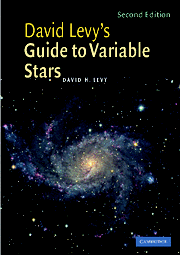Book contents
- Frontmatter
- Contents
- Foreword to the first edition
- Preface
- Acknowledgments
- Part I Getting to know the sky
- Part II Getting to know the variables
- 5 Meeting the family
- 6 Getting started with Cepheids
- 7 Algol, the demon of autumn
- 8 How to estimate a variable
- 9 Names and records
- 10 How your observations help us understand a variable star
- 11 Observing hints
- 12 Observing with CCDs
- 13 Stately and wonderful
- 14 Stars of challenge
- 15 Bright, easy, and interesting
- 16 Betelgeuse: easy and hard
- 17 Not too regular
- 18 Nova? What nova?
- 19 Supernovae
- 20 Clyde Tombaugh's star and the family of cataclysmic variables
- 21 A nova in reverse?
- 22 RU Lupi?
- 23 Orion, the star factory
- 24 Other variable things
- 25 The Sun
- Part III Suggested variables for observation throughout the year
- Part IV A miscellany
- Index
16 - Betelgeuse: easy and hard
from Part II - Getting to know the variables
Published online by Cambridge University Press: 05 August 2012
- Frontmatter
- Contents
- Foreword to the first edition
- Preface
- Acknowledgments
- Part I Getting to know the sky
- Part II Getting to know the variables
- 5 Meeting the family
- 6 Getting started with Cepheids
- 7 Algol, the demon of autumn
- 8 How to estimate a variable
- 9 Names and records
- 10 How your observations help us understand a variable star
- 11 Observing hints
- 12 Observing with CCDs
- 13 Stately and wonderful
- 14 Stars of challenge
- 15 Bright, easy, and interesting
- 16 Betelgeuse: easy and hard
- 17 Not too regular
- 18 Nova? What nova?
- 19 Supernovae
- 20 Clyde Tombaugh's star and the family of cataclysmic variables
- 21 A nova in reverse?
- 22 RU Lupi?
- 23 Orion, the star factory
- 24 Other variable things
- 25 The Sun
- Part III Suggested variables for observation throughout the year
- Part IV A miscellany
- Index
Summary
Estimating Betelgeuse
Clyde Tombaugh, who discovered Pluto in 1930, began his career with astronomy on a Kansas farm. To brighten up one long day of farming he asked himself, “How many cubic inches are there in Betelgeuse?” His answer, with what we know today, would have been 10 to the 41st power! On the next clear night he looked skyward, with a twinkle in his eye, to the reddish chief of Orion. One of its secrets given away, Betelgeuse twinkled back.
Orion is master of the winter sky. From city sky or country, from almost any part of the world, the majestic figure of the Hunter dominates the sky with belt, sword, and club. Look to the southeast early in a January or February evening, or to the south in a March evening, and discover Orion. The keys to this constellation are the three stars that line up in a neat row. The westernmost one is called Mintaka, a delightful Arabic name meaning belt. Using the belt as a beacon, Betelgeuse is one of the easiest stars in the sky to find. The three stars in a row are surrounded by a four-sided figure of four bright stars. The star in the northeast corner of the figure is Betelgeuse. The best time to see Betelgeuse is at the end of January, when it is in the sky most of the night.
- Type
- Chapter
- Information
- David Levy's Guide to Variable Stars , pp. 88 - 92Publisher: Cambridge University PressPrint publication year: 2005

